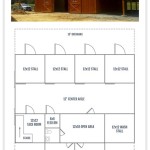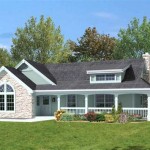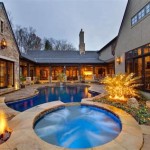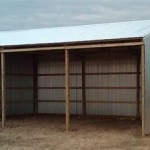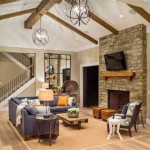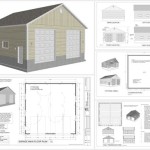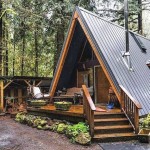One Story Lakefront House Plans: Designing for Seamless Waterside Living
One story lakefront house plans are increasingly sought after for their accessibility, aesthetic integration with the natural landscape, and potential for maximizing views of the water. These designs are particularly well-suited for individuals and families seeking a relaxed lifestyle centered around the lake, offering ease of movement and a strong connection to the outdoors. The development of a successful one story lakefront home requires careful consideration of site characteristics, architectural style, interior layout, and sustainable building practices.
The appeal of a single-story lakefront residence lies in its simplicity and convenience. Eliminating stairs makes the home easily navigable for individuals of all ages and abilities. This characteristic is especially advantageous for older adults or those with mobility limitations. Furthermore, a single-story design allows for a more horizontal layout, potentially maximizing the frontage along the lake and affording more rooms with direct waterfront views.
Key Considerations for Site and Orientation
The selection and orientation of the building site are crucial for any lakefront home, but particularly so for a single-story design. Factors that influence the site selection include the shoreline topography, soil conditions, existing vegetation, and prevailing wind and sun exposure. Assessing these characteristics before finalizing the plans is essential for optimizing views, minimizing environmental impact, and ensuring the structural integrity of the building.
The orientation of the house should be carefully planned to take advantage of natural sunlight and prevailing breezes. South-facing windows can maximize solar gain during the winter months, while carefully positioned overhangs, awnings, or strategically planted trees can provide shade during the summer. Orienting the house to capture prevailing winds can assist with natural ventilation, reducing reliance on air conditioning and promoting energy efficiency. Addressing the wind exposure is also vital because lakes can create funneling effects, thus requiring sturdy design considerations.
Preserving existing vegetation is also an important consideration. Integrating the house seamlessly into the landscape enhances its aesthetic appeal and helps to maintain the natural ecosystem around the lake. Protecting mature trees and shrubs provides shade, reduces erosion, and creates a sense of privacy. In some instances, landscaping may need to be specially selected to withstand seasonal flooding and other aquatic conditions.
Soil conditions are similarly important, and should be tested thoroughly before construction to guarantee the foundation's stability. Depending on the soil type, additional support may be required to prevent settling or shifting. If the site is prone to flooding, the house may need to be elevated, or the foundation may need to be reinforced with waterproofing materials. Local building codes and regulations often dictate minimum elevation requirements for lakefront properties.
Architectural Style and Interior Design for Lakefront Integration
The architectural style of a one story lakefront house should complement the surrounding environment and reflect the homeowner's personal preferences. There are various styles that are well-suited for lakefront living, ranging from rustic and traditional to modern and contemporary. Ultimately, the style should harmonize with the natural beauty of the location and enhance the overall living experience.
Rustic styles like Craftsman, Adirondack, or log cabin designs evoke a sense of warmth and connection to nature. These styles often feature natural materials such as wood, stone, and exposed beams. Large windows and expansive decks or porches are common elements, allowing for seamless indoor-outdoor living. The interior design often incorporates natural colors, textures, and patterns, creating a cozy and inviting atmosphere.
Modern and contemporary styles, on the other hand, tend to emphasize clean lines, minimalist forms, and large expanses of glass. These designs often feature open floor plans, sleek finishes, and a focus on maximizing natural light. Neutral color palettes and minimalist furnishings create a sophisticated and uncluttered aesthetic. Modern lakefront homes often incorporate smart home technology and energy-efficient features.
Regardless of the selected style, the interior layout should be designed to maximize views of the lake and create a functional and comfortable living space. Open floor plans promote a sense of spaciousness and allow for easy flow between different living areas. The kitchen, living room, and dining room are often combined into a single, unified space that overlooks the water. Bedrooms should be strategically positioned to provide both privacy and views.
Large windows, sliding glass doors, and skylights are essential for bringing natural light into the home and connecting the interior with the outdoors. These elements also provide unobstructed views of the lake and surrounding landscape. The use of natural materials such as wood, stone, and glass further enhances the connection to nature, creating a sense of harmony between the indoors and outdoors.
Outdoor living spaces are equally important to the overall design. Decks, porches, patios, and screened-in areas provide ample opportunities for relaxation, entertainment, and enjoying the lake. These spaces should be designed to seamlessly extend the indoor living areas, creating a fluid transition between the interior and exterior.
Sustainability and Energy Efficiency in Lakefront Homes
Sustainability and energy efficiency are important considerations for any new construction project, but they are particularly crucial for lakefront homes. Building a sustainable lakefront home helps to minimize environmental impact, conserve natural resources, and create a healthier and more comfortable living environment. Incorporating energy-efficient features can also significantly reduce operating costs over the long term.
Energy-efficient windows and doors are essential for minimizing heat loss in the winter and heat gain in the summer. Low-E glass, insulated frames, and tight seals can significantly improve the thermal performance of windows and doors. Proper insulation of walls, roofs, and floors is also crucial for maintaining a consistent indoor temperature and reducing energy consumption.
Energy-efficient heating and cooling systems, such as geothermal heat pumps or high-efficiency furnaces and air conditioners, can further reduce energy costs. Solar panels can provide a renewable source of energy, reducing reliance on fossil fuels and lowering electricity bills. Smart home technology can also help to optimize energy usage by automatically adjusting lighting, heating, and cooling based on occupancy and weather conditions.
Water conservation is another important aspect of sustainable lakefront living. Low-flow toilets, showerheads, and faucets can significantly reduce water consumption. Rainwater harvesting systems can collect rainwater for irrigation and other non-potable uses. Landscaping with drought-tolerant plants can also help to conserve water and reduce the need for irrigation.
Sustainable building materials, such as recycled wood, bamboo, and reclaimed materials, can further reduce the environmental impact of the construction process. Using locally sourced materials can also help to reduce transportation costs and support local economies. Choosing paints, adhesives, and sealants with low volatile organic compounds (VOCs) can improve indoor air quality and create a healthier living environment.
The design and construction of a septic system is another extremely important consideration as the system must function properly and prevent any seepage or leakage into the lake. Local regulations often mandate a certain distance from the lakeshore, soil testing, and periodic inspections to guarantee that the system is functioning as intended.
Ultimately, a well-designed one story lakefront home plan will not only provide a beautiful and comfortable living space, but will also minimize its impact on the sensitive lakefront environment. By considering site characteristics, architectural style, interior layout, and sustainable building practices, homeowners can create a lakefront retreat that they can enjoy for years to come.

House Plan 1070 00129 Lake Front 1 375 Square Feet 2 Bedrooms Bathrooms Vacation Plans

Lake House Plans Waterfront Monster

Lake House Plans Blog Homeplans Com

House Plan

Sloped Lot House Plans Walkout Basement Drummond

3 Bedroom Open Floor Plan With Wraparound Porch And Basement

Lake House Plans Floor Lakefront The Designers

Open Concept Small Lake House Plans Houseplans Blog Com

Best Lake House Plans Waterfront Cottage Simple Designs

Lake House Plans Blog Homeplans Com

